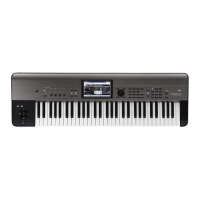Sequencer: Menu Command Bounce Pattern
187
it as a user pattern. Be aware that when you execute the
Copy Pattern operation, the pattern settings and musical
data of the copy destination will be erased.
1. In From (Song***): Pattern, specify the copy source pat-
tern. (By default, this will be the song and pattern that
was selected in the Pattern Edit page.)
2. In To: Song and Pattern, specify the copy destination
song and pattern.
For Pattern, only user patterns U00–U99 can be specified.
Bounce Pattern
This command combines the musical data of a source
pattern and a destination pattern, and places the combined
musical data in the destination. The time signature and
length of the pattern following execution will be according
to the settings of the destination pattern. Unlike the Track
Bounce operation, the musical data of the bounce source will
not be erased.
If MIDI control data exists in the selected pattern and in the
bounce destination pattern, the resulting playback following
the bounce operation may produce unexpected results. We
recommend that you use Event Edit to prepare the MIDI
control data of the two patterns before executing the Bounce
Pattern command.
1. Pattern and Pattern Select to specify the bounce source
pattern.
2. Select “Bounce Pattern” to open the dialog box.
3. In From (Song***) Pattern, select the bounce source pat-
tern. (By default, the song and pattern that are selected
in the Pattern Edit page will be chosen.)
4. In To: Song and Pattern, select the bounce destination
song and pattern. For Pattern, only user patterns U00–
U99 can be specified.
Get From Track
This command takes musical data from a track and loads it
into the specified pattern.
1. Use Pattern and Pattern Select to specify the pattern.
2. In Pattern Parameter, specify the pattern length of the
“get” destination.
3. Select “Get From Track” to open the dialog box.
4. In Song, select the “get” source song.
5. In Track, select the “get” source track.
6. In Measure, specify the first measure of the “get”
source.
Put To Track
This command places a pattern into a track.
Unlike the Copy to Track, this command only places the
pattern number in the song, so that when playback reaches
that point, the pattern will be recalled. The musical data of
the pattern will not actually exist in the track.
By creating patterns that contain frequently‐used phrases or
drum patterns, and then placing them on the tracks, you can
conserve memory.
Be aware that when you edit a pattern, all locations in the
song where that pattern has been placed will be affected.
When you execute the Put to Track command, the musical
data will be affected as follows.
• Musical data previously existing at the “put” destination
will be erased.
• The pattern that you “put” will playback according to the
time signature that is specified by the measures of the
“put” destination.
• Control data such as pitch bend etc. previously existing in
the track will be reset immediately before the measure at
which the pattern was “put.” If you wish to use control
data such as pitch bend in the measures in which a
pattern is “put,” you must first write the control data into
the pattern (see “Control data in pattern recording” on
page 156).
To delete a pattern that has been placed in a track you can
use Erase Measure, specifying the area in which the pattern
was “put,” and setting Kind to All.
1. Select “Put To Track” to open the dialog box.
2. In Pattern and Pattern Select, select the “put” source
pattern. (By default, this will be the pattern selected in
the Pattern Edit page)
3. In To: Track, select the “put” destination track.
1 2
Track 10
(Drums)
3 456
Pattern 20
Example: Pattern 20 has been Put at measures 2, 4, and 6 of track 10. When those
measures are reached, pattern 20 is called and its data is played.

